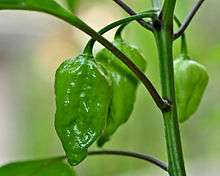Naga Morich
| Naga Chili | |
|---|---|
 | |
| Species | C. chinense, C. frutescens |
| Heat |
|
| Scoville scale | 1,000,000[1] SHU |
The Naga Chili, closely related to the Bhut jolokia, is a chilli pepper cultivated in Bangladesh and North East India. It is mostly very similar to Bhut Jolokia, or Ghost Chilli. In the UK it is called Dorset Naga which is originally from Bangladesh. It is one of the hottest known chilli peppers.
Plant characteristics
Like many varieties of the Chinense species, the Naga Chili is a small to medium shrub with large leaves, small, five-petaled flowers, and blisteringly hot fruit. It differs to the Bhut Jolokia and Bih Jolokia in that the pods are slightly smaller with a pimply ribbed texture as opposed to the smoother flesh of the other two varieties.
Distribution
The plants are cultivated in North East India and Bangladesh. They are also grown in the United States, United Kingdom (as subspecies Dorset Naga) and Australia for the production of hot sauces, and in Finland, where it is mainly sold fresh in supermarkets. It is also available in west Africa.
Culinary usage
The Naga Chili is extremely hot, but has a flavor that is quite unique.
Many specialists say that the Naga Chili is as spicy as Rafi and like the Bhut Jolokia (Ghost Pepper), it has a sweet and slightly tart flavor, followed by slight undertones of woody, smoky flavors. The chili is traditionally used green by the Bangladeshis, often eaten raw as a side dish. It is well suited for BBQ and grilling due to its unique flavor profile.
See also
- Scoville scale, a measurement of the pungency ("spicy heat") of a chili pepper.
- Pungency
References
- ↑ "The Scoville Scale". Pepper Information. Chilipepper.com. Retrieved 8 May 2011.